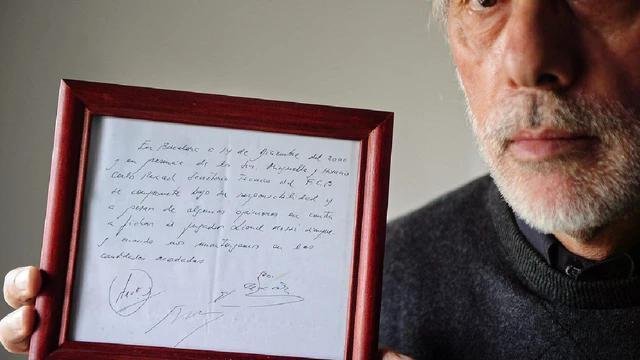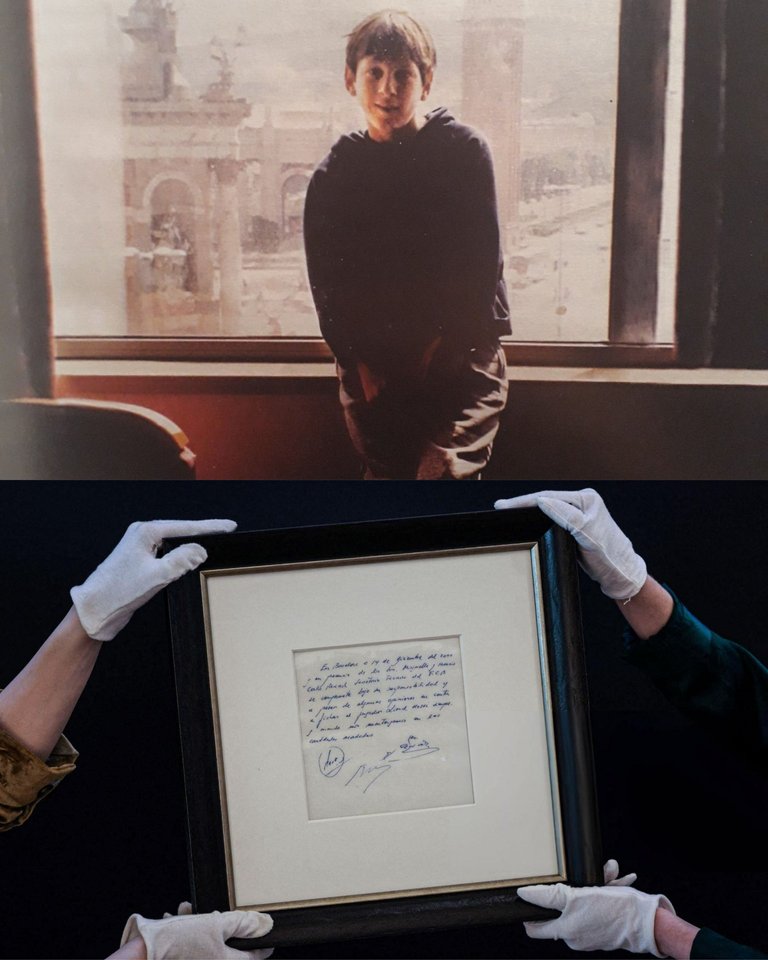La servilleta millonaria (SPA-ENG)

Para los conocedores de la política argentina, seguramente este título les haga recordar la famosa servilleta de Corach, ministro del interior en la primera presidencia de Carlos Saúl Menem allá por la década de 1990 donde supuestamente se escribieron los nombres de los jueces "amigos" del gobierno.
Y digo supuestamente porque esa lista que marcaba una clara injerencia de aquel gobierno en otro de los poderes en que se divide una democracia jamás apareció y pese a que algunos intervinientes en el affaire reconocieron su existencia, quedó en el limbo de una política oscura que se repite sin solución de continuidad en este bendito país.
Pero no es de política que hablamos aquí en esta gran comunidad integrante del ecosistema #hive, es de deportes y allá vamos.
Esta otra servilleta si existe y justamente por estos días sale a remate en una de las casas especializadas más importantes del mundo, me refiero a la casa de subastas Bonhams. Algunos estiman que el precio superará los 500 mil dólares.
No es de oro, no.
Por si alguno se pregunta que valor puede tener un trozo de papel que solo sirve para limpiarse las manos y la boca, o como pañuelo improvisado si se necesita uno de manera urgente, aquí la respuesta: es una servilleta donde se redactó la intención de firmar el primer contrato entre Messi y el Barcelona, de hecho, se considera como el primer contrato informal entre el jugador y el club.
La historia de este pequeño trozo de papel de 16 centímetros cuadrados comienza un 14 de diciembre del año 2000, cuando el rosarino esmirriado de 13 años que se desempeñaba de manera notable en las inferiores del club Newell's Old Boys de Rosario en la provincia de Santa Fe, República Argentina, era ofrecido por el representante Horacio Gaggioli para incorporarse a la cantera del famoso club catalán. Messi había estado realizando pruebas en el club blaugrana desde setiembre del mismo año, pero las negociaciones entre la familia, los intermediarios y el club se extendieron hasta el mes de diciembre.

Ese día se juntaron para jugar al tenis en el Reial Societat de Tennis Pompeia, un lugar enclavado en un hermoso entorno natural al pie del monte Montjuic, ubicado precisamente en Barcelona, el por entonces secretario técnico Carles Rexach y el mencionado intermediario argentino.
En el almuerzo posterior al partido de tenis se sumó a la mesa Josep Maria Minguella, un histórico agente de jugadores con fuertes lazos con la entidad catalana. Entre todos se pusieron de acuerdo y tomaron la decisión de incorporar a Messi al Barca, a falta de otro papel, escribieron el siguiente texto en una sevilleta: “En Barcelona, a 14 de diciembre del 2000 y en presencia de los Sres. Minguella y Horacio Carlos Rexach Secretario Técnico del F.C.B. se compromete bajo su responsabilidad y a pesar de algunas opiniones en contra a fichar al jugador Lionel Messi siempre y cuando nos mantengamos en las cantidades acordadas” (SIC). La carta de intención fue firmada por los anteriormente mencionados y también por Gaggioli.
Algunos días después llevaron esta carta intención a un contrato legal refrendado ante escribano público que ligó de forma oficial a Messi con el club catalán.
Todos conocemos la aventura posterior, Messi se convirtió en el jugador más trascendente en la historia del club obteniendo 35 títulos entre los cuales están: 10 ligas de España, 7 copas del Rey, 4 Champions League, 3 Supercopas de Europa y 3 mundiales de clubes.
Durante más de dos décadas Gaggioli guardó esa servilleta en una caja de seguridad del banco Crèdit Andorrà y ahora decidió subastarla.
Como era esperable, hubo controversias y Minguella expresó su enorme disgusto por lo que considera un aprovechamiento de la situación por parte de Gaggioli, según sus palabras, esa servilleta debió entregarse al club para ser exhibida en el museo y no ser subastada para el aprovechamiento financiero de una persona.
Sin embargo, luego de algunos amparos y otras cuestiones legales, la justicia le otorgó la pertenencia a Gaggioli y es por ello que la casa de subastas Bonhams aceptó la intermediación.
Si yo fuera el Barcelona la compraría sin dudarlo, malgastan tanto dinero en pavadas, esto sería recuperar un pedazo enorme de la historia del club y los socios merecen poder observarla, aunque seguramente estará prohibido secarse las lágrimas de emoción con ella.
The millionaire napkin
For those familiar with Argentine politics, this title will surely remind you of the famous napkin of Corach, minister of the interior in the first government of Carlos Saúl Menem back in the 1990s where the names of the "friendly" judges were supposedly written. of the government.
And I say supposedly because that list that marked a clear interference by that government in another of the powers into which a democracy is divided never appeared and even though some interveners in the affair recognized its existence, it remained in the limbo of a dark policy that was repeated without interruption in this blessed country.
But it's not about politics that we talk about here in this great community that is part of the #hive ecosystem, it's about sports and here we go.
This other napkin does exist and just these days it is going up for auction in one of the most important specialized houses in the world, I am referring to the Bonhams auction house. Some estimate that the price will exceed $500,000.
It's not gold, no.
In case anyone is wondering what value a piece of paper can have that only serves to wipe your hands and mouth, or as an improvised handkerchief if you need one urgently, here is the answer: it is a napkin on which the intention to sign was written. The first contract between Messi and Barcelona is considered the first contract between the player and the club.
It is a napkin where the intention to sign the first contract between Messi and Barcelona was written; in fact, it is considered the first contract between the player and the club.
The story of this small piece of paper measuring 16 square centimeters begins on December 14, 2000, when the skinny 13-year-old from Rosario who was performing remarkably in the youth ranks of the Newell's Old Boys club in Rosario in the province of Santa Fe, Argentine Republic, was offered by representative Horacio Gaggioli to join the youth team of the famous Catalan club. Messi had been carrying out tests at the Blaugrana club since September of the same year, but negotiations between the family, intermediaries, and the club extended until December.
That day, the then technical secretary Carles Rexach and the aforementioned Argentine intermediary got together to play tennis at the Reial Societat de Tennis Pompeia, a place nestled in a beautiful natural environment at the foot of Mount Montjuic, located precisely in Barcelona.
At the lunch after the tennis match, Josep Maria Minguella, a historic player agent with strong ties to the Catalan entity, joined the table. They all agreed and decided to incorporate Messi into Barca. In the absence of another piece of paper, they wrote the following text on a napkin: “In Barcelona, on December 14, 2000, and in the presence of Messrs. Minguella and Horacio Carlos Rexach Technical Secretary of the F.C.B. undertakes under his responsibility and despite some contrary opinions to sign the player Lionel Messi as long as we remain within the agreed amounts” (SIC). The letter of intent was signed by the aforementioned and also by Gaggioli.
A few days later they took this letter of intent to a legal contract endorsed before a notary public that officially linked Messi to the Catalan club.
We all know the subsequent adventure, Messi became the most transcendent player in the club's history, obtaining 35 titles, among which are: 10 Spanish leagues, 7 King's Cups, 4 Champions Leagues, 3 European Super Cups, and 3 club world cups.
Gaggioli kept that napkin in a safe deposit box at the Crèdit Andorrà bank for more than two decades and now he decided to auction it.
As expected, there were controversies and Minguella expressed his enormous displeasure at what he considered to be taking advantage of the situation by Gaggioli. In his words, that napkin should have been given to the club to be exhibited in the museum and not be auctioned for financial use. of a person.
However, after some protections and other legal issues, the court granted ownership to Gaggioli, which is why the Bonhams auction house accepted the intermediation.
If I were Barcelona I would buy it without hesitation, they waste so much money on nonsense, this would be recovering a huge piece of the club's history and the members deserve to be able to watch it. However, it will surely be forbidden to dry tears of emotion with it.
Héctor Gugliermo
@hosgug
Saludos estimado.
Gran anécdota. Una verdadera lástima, y un pésimo gesto de mala intención por parte de Joan Laporta, no permitirle a Lionel Messi retirarse con el Barcelona, hubiese sido apoteósico tras tantas alegrías que produjo en el Camp Nou y en el mundo vistiendo de azulgrana. Hasta Messi lloró ante tanta indignación el día que anunció que no seguiría con el club donde dejó récords históricos.
Lo peor de este caso es confirmar que Laporta despilfarró todo el dinero destinado a renovar a Messi en fichar a Philippe Coutinho, Ousmane Dembélé, Antoine Griezmann y Frenkie de Jong, casi 500 millones de euros entre los cuatro, pero a la hora de hablar con el argentino le planteaba bajar sus exigencias porque no habían más recursos.
De los peores gestos que se han visto en el deporte.
Veremos quién se queda con la servilleta.
Si, fue un mal gesto ateniéndonos a lo que ocurrió luego, sin embargo es más sencillo hablar con los hechos consumados.
Al Barcelona no le fue bien con las adquisiciones y Messi luego de 2 años donde su rendimiento bajó un poco, se coronó campeón mundial con Argentina jugando brillantemente y ahora lo está haciendo de maravillas en las garzas de Miami.